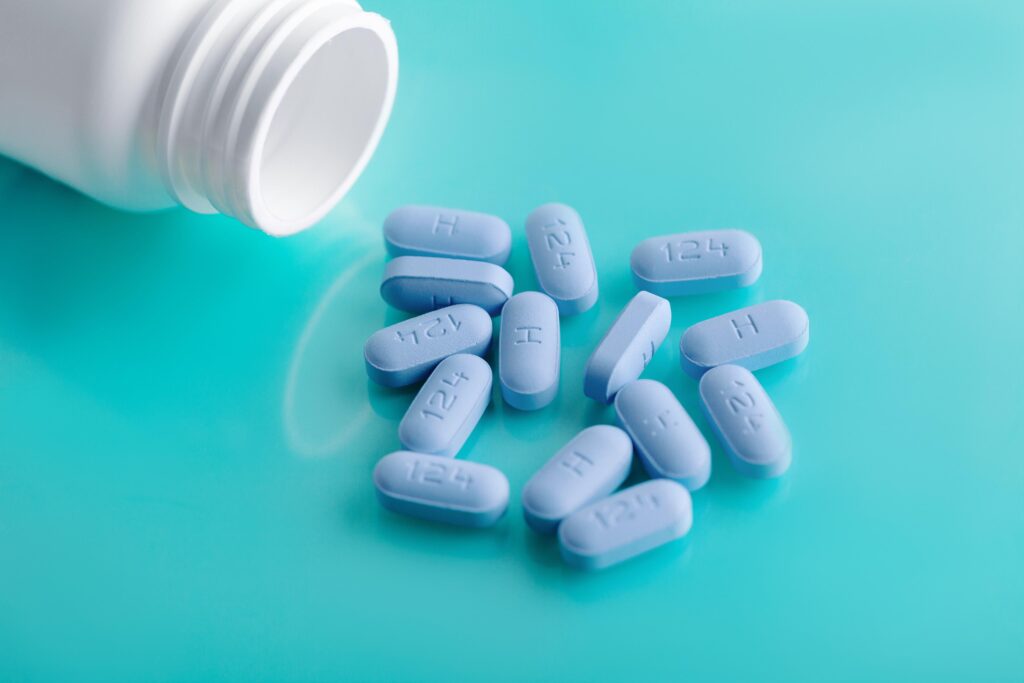Pre-exposure prophylaxis – PrEP – is medicine (pills or shots) that reduces your chance of getting HIV. PrEP is for adults and adolescents without HIV who may be exposed to HIV through sex or injection drug use. PrEP may be an option to help protect pregnant people and their babies from getting HIV while trying to get pregnant, during pregnancy, or while breastfeeding. Talk to your healthcare provider.
PrEP safety & interactions
PrEP is safe to take. Some people experience side effects like diarrhea, nausea, headache, fatigue, and stomach pain. These side effects usually go away over time. However, it would help if you talked to your healthcare provider about any severe or persistent side effects.
PrEP & birth control
There are no known interactions between PrEP and hormone-based birth control methods, e.g., the pill, patch, ring, shot, implant, or IUD. It is safe to use both at the same time.
PrEP & hormone therapy
There are no known drug conflicts between PrEP and hormone therapy. It is safe to use both at the same time.
Did you know?
PrEP reduces the chance of getting HIV but doesn’t prevent other STIs or pregnancy. Condoms can help prevent certain other STIs and pregnancy.
PrEP effectiveness
PrEP dramatically reduces your chance of getting HIV from sex or injection drug use.
- For receptive anal sex (bottoming), PrEP pills reach maximum protection from HIV at about seven days of daily use.
- For receptive vaginal sex and injection drug use, PrEP pills reach maximum protection at about 21 days of daily use.
- No data are available for PrEP pill effectiveness for insertive anal sex (topping) or insertive vaginal sex.
- We don’t know how long it takes for PrEP shots to reach maximum protection during sex.
Deciding if PrEP is right for you
PrEP can help protect you if you don’t have HIV and any of the following apply to you:
You have had anal or vaginal sex in the past six months, and you
- have a sexual partner with HIV (especially if the partner has an unknown or detectable viral load),
- have not consistently used a condom or
- have been diagnosed with a sexually transmitted disease in the past six months.
You inject drugs, and you
- have an injection partner with HIV, or
- share needles, syringes, or other drug injection equipment (for example, cookers).
You have been prescribed PEP (post-exposure prophylaxis), and you
- report continued risk behavior or
- have used multiple courses of PEP.
You may take PrEP even if the above behaviors don’t apply.

Paying for PrEP
Most insurance plans and state Medicaid programs cover PrEP. Under the Affordable Care Act, PrEP must be accessible under almost all health insurance plans. That means you can’t be charged for your medication, clinic visits, and lab tests needed to maintain your prescription.
If you don’t have insurance or Medicaid coverage, other programs provide PrEP for free or at a reduced cost:
- Co-pay assistance programs help lower the costs of PrEP medications. Income is not a factor in eligibility.
- ViiVConnect offers a program to help pay for PrEP shots.
- Some states have PrEP assistance programs. Some programs cover PrEP medication, while others cover clinic visits and lab tests. Some programs cover both.
Starting PrEP
If you think PrEP is right for you, talk to your healthcare provider. Any licensed healthcare provider can prescribe PrEP. Before starting PrEP, you must take an HIV test to make sure you don’t have HIV. While taking PrEP, you’ll have to visit your healthcare provider routinely as recommended for:
- follow-up visits,
- HIV tests, and
- prescription refills or shots.
Ask your healthcare provider about mail-in HIV tests and telehealth services for follow-up visits. If you are receiving PrEP shots, you’ll need to visit your healthcare provider for your shot.
Staying on PrEP
It would help if you took PrEP as prescribed for it to work. If you do not take PrEP as prescribed, there may not be enough medicine in your bloodstream to block the virus. The right amount of medicine in your bloodstream can stop HIV from taking hold and spreading in your body.
Stopping PrEP
There are several reasons why people stop taking PrEP. Talk to your healthcare provider if you’re thinking about stopping PrEP. They’ll discuss how to stop PrEP safely and suggest other HIV prevention methods that may work better for you.
On-demand PrEP
Some people take PrEP pills only when they have a high chance of getting HIV. It is known as “on-demand” PrEP or “intermittent,” “non-daily,” “event-driven,“ or “off-label“ PrEP use.
- The type of “on-demand“ PrEP that has been studied is the “2-1-1“ schedule. This means taking two pills 2-24 hours before sex, one pill 24 hours after the first dose, and one pill 24 hours after the second dose.
- There is scientific evidence that the “2-1-1“ schedule provides adequate protection for gay and bisexual men when having anal sex without a condom.
- We don’t know how “on-demand“ PrEP works for heterosexual men and women, people who inject drugs, and transgender people.
Some health departments in the United States and some health organizations in Europe and Canada offer guidance for “on-demand“ PrEP as an alternative to daily PrEP for gay and bisexual men.
Although the updated PrEP guideline provides information on correctly using the “2-1-1” schedule, this approach has not been approved by the U.S. Food and Drug Administration (FDA) and is not recommended by the CDC. Taking PrEP as prescribed is currently the only FDA-approved schedule for taking PrEP to prevent HIV.

